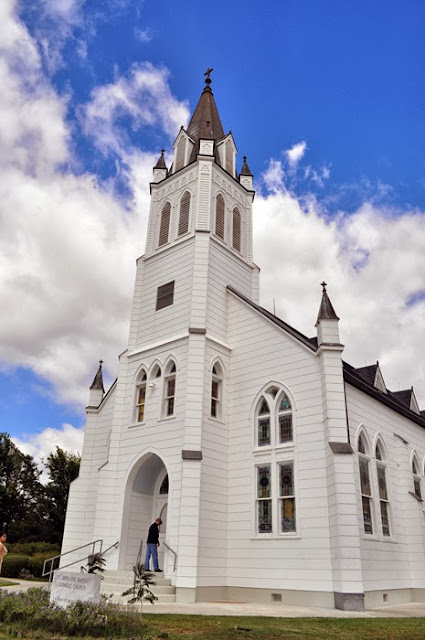Czech it out!
Dan recently joined the Mercedes Benz Club in Austin. One strong incentive for joining was access to good parking when he attends some of the races at Circuit of the Americas. Today was our first time to meet up with other members, and it was for an all-day tour of four of the "Painted Churches" located in the region south and east of Austin. We had a great time and met some very nice folks. |
| We all had lunch at Kloesel's in Moulton. They reserved this entire room for the club. |
These churches were built by the German and Czech immigrants who still, to this day, populate this region. I understand that there are other denominations with equally impressive painted churches in Texas, but the four we toured were all Catholic. As we caravanned from town to town, with the other club members, I began to feel as if I was no longer in America. The foods, the architecture, much of the written and spoken words, are heavily influenced especially by the Czech population there. And, speaking of FOOD, we were tempted at every turn by scrumptious Kolache. I had a ham and cheese Kolache for breakfast, and then, as we were heading home in the late afternoon, we stopped at another local bakery for fruit-filled Kolaches. So much for today's carb count!
Moravia/Praha
The first church we visited, with our tour guide, was in the Moravia/Praha area. It was a stone building, with lovely grounds. We were told that the ceiling of these churches were supposed to represent the inside of Noah's ark, and it wasn't difficult to see the similarity to boat-architecture. A distinctive feature of this Praha church was the huge Czech crystal chandelier.
High Hill
The High Hill church was, for me, the most beautiful and elaborate of the four buildings. It was built of red brick. Inside were what appeared to be marble columns, but at closer inspection, the columns were wooden and only painted to look like marble. Our tour guide told us that the parishioners laboriously painted these columns using turkey feathers, in order to attain the marble look.
 |
| The faux-painted columns, made to look like marble. |
 |
| I used a wide-angle adapter, attached to the front of my 18-55 zoom lens (set at 18) to capture this ceiling shot (thus my "Wide Angle" theme, noted at the top of the post). |
Ammansville
The last two churches, Ammansville and Dubina, were clad in white clapboard. The interior of the Ammansville one was probably the simplest of all of them. Our tour guide told us that at some point the decorative painting had been covered over with plain coats of paint. Many years later (I believe it was in the 1980s) a young man asked if he could remove a portion of the paint to see if the artistic painting was still beneath it, and whether it could be salvaged. Although some touch-up was needed, the majority of the old art work was able to be uncovered and restored.
Dubina
The Dubina church was strikingly different than the others. Its ceiling and walls were covered in a beautiful sky-blue paint with six-pointed platinum stars. It was really quite enchanting.
Piano Bridge
We heard about this pretty little bridge from our tour guide. She told us that the bed of the old bridge that once crossed the river here, so that people could get to church, was made of boards. The boards were always loose, so when the wagons or Model Ts crossed, the boards made distinctive "plinks" and "plunks", sounding something like a piano melody; thus the name Piano Bridge, which was passed on to the new, concrete bridge, as well.






















1 comment:
Beautiful documentation of the tour of churches.
Post a Comment